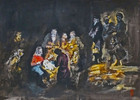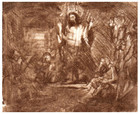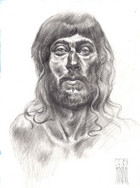Hari Mitrushi
In 1967, Albanian Communist Dictator Enver Hoxha declared his country to be the “first atheist state in the world,” confident his totalitarian regime’s harsh punishments for religious activities and closure of over 2000 religious institutions would end faith once and for all in the Balkan nation. History has had the last laugh at Hoxha and his comrades, so paranoid of the outside world they had one bunker built for every four Albanians! Almost three decades after the fall of Communism, new mosques and churches have sprouted up beside these grim concrete reminders of the past and recent polls show over half of Albania's citizens claim some kind of religious belief.
Albanian Artist Hari Mitrushi offers living proof of how faith can survive amid persecution. Born five years before Hoxha’s boastful pronouncement, Mitrushi came into the world already branded “an enemy of the people,” limited in where he could live and what he could do in life with no chance of a higher education. His father’s family had been active in politics under the “old regime;” his mother’s relatives were prosperous “bourgeois” business folk; and if all this were not suspect enough for Albania’s security services, the Mitrushis were members of the country’s small but influential Evangelical Christian community.
Mitrushi’s grandfather, Hari, was a co-worker of the American Protestant Missionary, Phineas Kennedy, who ran an Albanian-language school in the southern city of Korce in the final years of the Ottoman Empire and helped the Albanians plead their case for independence at the Versailles Peace Conference ending World War I. Mitrushi tells how his grandfather was saved from execution for his nationalist activities by the intervention of President Woodrow Wilson and escaped death a second time at the hands of the Communists because of his skills as a translator. The Elder Hari would spend 18 years in prison camps and die a martyr to the faith.
Those of us who live in Western-style democracies have little idea of what the Mitrushi clan had to endure. The artist believes the constant fear of imprisonment brought about his father’s early death, but the family’s faith in Christ gave them the strength to go on and make a new life for themselves after the fall of the Communist regime in late 1990. “Our Lord shines brighter in the darkness,” says Mitrushi. “Painting is my way of thanking Him for being with us, when we passed through the Valley of the Shadow of Death. All my work has this goal, whether I paint a still life, a portrait, or a landscape.”
The first cracks in Mitrushi’s bunker walls came after Hoxha’s death in 1985, when the new Communist leadership allowed limited contacts with the outside world. A French cultural attache visiting Albania in 1988 purchased one of his paintings. The largely self-taught artist, then, won a scholarship to the Florence Art Academy in Italy. Mitrushi eventually immigrated with his family to Thessaloniki, Greece, where he has been an art teacher for the past 25 years, devoting his free time to creating prints, paintings, and watercolors, inspired by the great masters of Western art.
The Nativity scene by Mitrushi in the collection pays homage to the 17th century Adoration of the Shepherds from the school of Rembrandt in the National Gallery in London and his two prints of Christ blessing the world and the Apostle Paul recall the biblical etchings of the Dutch artist. We see an image of Christ’s Passion with Balkan motifs in Two Strangers, bringing to mind the Spanish Renaissance and Baroque masterworks of El Greco and Velazquez. In Mitrushi’s expressionistic rendering of the Parable of the Sowers, The Planters, there are suggestions of the Austrian Early Modernists, Egon Schiele and Oskar Kokoschka.
The work in the collection best epitomizing Mitrushi’s style of sacred art-making, so rooted in his personal history, is a pencil on paper portrait of Christ, simply titled, Jesus. Stripped of the supernatural trappings of haloes and the “pretty-boy” romanticism of conventional Christ imagery, this raw-boned, broad-nosed, fleshy-lipped Savior of the World holds us with a gaze full of infinite compassion and understanding of our heartless ways. This is truly a “man of sorrows and acquainted with grief (Isaiah 53:3, KJV).”






